Learn from my mistakes
Synopsis : “It’s good to learn from your mistakes. It’s better to learn from other people’s mistakes.” Here are some related ones of mine and the lessons I (again) learned from them.
Introduction
This is the 50th post of the year. Usually {{1}} this is the week in which I write some erudite words {{2}} about the season in retrospect.
What went well, what could have gone better and what was an unmitigated disaster. The highs and the lows, together with a smattering of the in-between bits that actually constitute the majority of the beekeeping year.
Writing these review-type posts is quite enjoyable {{3}}. I have to go back through my hive notes which inevitably brings back a flood of memories of warmer days, heavy supers, lost hive tools and unmated queens.
These notes are succinct – rarely more than ~10-20 words – littered with acronyms but surprisingly informative. At least they are when you take into account their dates and the timing of the development cycle of workers, drones and queens.
And, as a bonus, they are also legible.
Hive records
I’ve mentioned before that I take my hive inspections records on a digital recorder in the apiary and then transfer them to a spreadsheet with the company of a coffee {{4}} later.
Whilst this approach misses the immediacy of a scribbled note on a sheet of paper under the hive roof, it does allow me to easily refresh my memory before the next apiary visit.
It also means they don’t blow away, get damp, eaten by slugs or require me to have a functioning pen in my beesuit … the recorder lives in the bee bag, so is always available.
By looking at the hive records in advance I’m reminded that – for example – I need more supers for hives #23 and #27, that the former had a good open queen cell on frame 7 (OC/7 in the notes) which should now be sealed {{5}} and that nuc #13 has a recently mated queen who will need finding (!), clipping and marking.
And by looking at the same records in mid-December, with the temperature plummeting outside, I can see how the season progressed week-by-week in my three main apiaries.
The nuc was sold a fortnight later, the queen in #23 eventually emerged but was lost before she got mated (or perhaps on her way back) and supers filled so rapidly that I regretted not adding more at once.
It was a great year for honey, the best since returning to Scotland in 2015.
But that can wait until the review of the season … which will now be next week {{6}}.
Impressions vs. reality
I give a lot of talks on beekeeping. Whilst a talk might be about bait hives, swarm control or queen rearing, the questions afterwards can be more wide-ranging. It is quite fun to get questions on apparently random beekeeping topics (I’ve done ’ask the expert’ {{7}} panels at beekeeping conventions which are enjoyable; for one question and four panel members you get six different answers and a good-natured argument … no wonder we run out of time).
Some of the more ‘left field’ questions can be a challenge and require a degree of lateral thinking. I’m more than happy to acknowledge that I’m sometimes stumped for an answer … I understand the question, but I cannot explain why whatever happened {{8}}, er, happened.
However, the very fact that I’m asked for an opinion at all suggests that I give the impression I know what I’m talking about {{9}} when it comes to almost any subject about honey bees.
I don’t.
Hive inspections
Even if you just restrict the topic to the hive, its contents and what’s happening in it on a week-to-week basis, the apparent impression some have of my understanding can be wildly different from reality.
I know that because of my hive notes.
And I’m acutely aware of this because I’ve just re-read them … 😉 .
Perhaps I’m not being entirely fair. If you read the entries for any individual week in isolation it’s clear I sometimes don’t have a scooby {{10}} what’s happening in the hive.
It’s obvious because as well as acronyms there’s a dusting of ??? throughout the notes {{11}}.
Not every hive and certainly not every week (thankfully), but more often than I’d like.
However, the regular repeat visits combined with the utter predictability of honey bee development, and comparison with adjacent hives, usually allows me to work out what’s happening with some certainty.
I think the take home message {{12}} here is that hive notes are very useful. Even if you don’t quite understand what’s happening in the hive, record what you see.
At the next visit, or the one after that, it should start to make sense.
And, when you re-read them in midwinter with the benefit of knowing what happened time, tea and a roaring stove, you’ll at least learn what to do in the same situation next year.
Or what not to do 🙁 .
Train wreck
But, there remains this disconnect between that impression of insightful understanding and the day-to-day reality of some of my apiary visits.
These are are not always as polished and assured as I’d like …
… frankly, they can sometimes be a bit of a train wreck.
I trip over or drop stuff {{13}} .
I reassemble the hive leaving the queen in a JzBz cage in my pocket.
Hives are inspected in the wrong order, meaning I might have to re-open one again to the understandable irritation of the bees.
I leave the hive tool inside a hive and can’t find another, or put it in the wrong pocket of my beesuit so it falls through the hole, down the inside of the leg and into my boot.
An elusive unmarked queen is found on my third run through the brood box … at exactly the same time as I find a suicidally psychotic worker inside my veil. I have insufficient hands to hold the frame, the queen and the worker (though, truth be told, I’m probably not intending to just ’hold’ the worker if she’s that agitated). The queen is abandoned until the following week.
When I fail to find her altogether.
Or, I do and she dies as I pick her up.
Composed and unruffled
Thankfully, not every apiary visit is like that.
Many are reassuringly ‘composed and unruffled’; I open the box, the bees are wonderfully calm. The queen is on the second frame I check, but the first had eggs anyway so I didn’t need to see her. However, since I found her and she’s mated and laying well, I mark her and clip her wing. The colony barely notice her absence and I run her gently back in between two brood frames to get on with her business.
This is the beekeeper I’d like to always be … not that other ham-fisted muppet in an ill-fitting beesuit.
Here are a couple of queen-related examples from the season just gone. At the time I was flummoxed. In retrospect I’ve learned a few important lessons.
Or re-learned those that I had been taught already … and subsequently forgotten 😉 .
A tale of several queens
Almost all of my swarm control these days uses the nucleus method. In comparison to the widely-taught Pagden artificial swarm it only requires an additional nuc box. In my experience, it is almost totally foolproof as long as:
- you take care to only leave a single queen cell in the hive; remember, this requires a visit one week after removing the queen. They cannot swarm if you leave just one cell.
- you don’t make the nuc too strong; if you do there’s a chance it might swarm anyway.
My colony #7 contained an ageing but really lovely queen. I’d used her last year for queen rearing and hoped to do so again. At the start of May I’d obviously tempted fate by noting … ’Strong. Lovely BP. PC only … graft next week’ {{14}}.
And, of course, the next week (the 8th of May) there were a couple of big, fat, 3-4 day old (i.e. open) queen cells and it was clear they were making plans to vamoose. I made up a nuc (number #47) with the old queen and moved her to a distant apiary.
One cell was left in box #7.
This box had overwintered with a nadired super and the original queen had snuck down in April and laid it up. Irritatingly, she’d chosen the frames of drone comb … not the end of the world because the queen was so good, but I didn’t want the new queen to do a repeat performance so moved the super above the queen excluder (QE). I discussed this in Early season inspections back in April – go there for all the gory details.
Upper entrances
Drones emerging above a QE is a recipe for carnage as they try and squeeze through {{15}}, so I added a thin eke that included an upper entrance. The drones could fly from this and, in due course, they did.
In the meantime, the new queen should have emerged and got mated … but she was nowhere to be found. There were polished cells in the brood box and the colony was behaving as though it was queenright.
On the 12th of June I decided to give it ’one more week’ and, eventually, I then found her in the supers on the 19th, together with several frames of open brood.
Since there was no sealed brood she had presumably been slow getting mated and only started within the last week or so. I clipped and marked her and returned her to the brood box.
But she didn’t stay long.
My notes on the 21st of July include the comment ’no eggs’ (there had been on the 12th) and at the end of the month I found a new laying queen in the box.
She’s still there … or was when I last checked the colony (’lovely, well-tempered bees’ I was pleased to record in my notes) in mid-September. I presume the previous one hadn’t been ‘up to scratch’ and so was superseded sometime in mid-July .
Lessons learned
When I removed the supers (unsurprisingly disappointingly light 🙁 ) and the plastic QE I found the latter had a couple of cracks in it. Although these didn’t result in any gaping holes, it’s possible the QE deformed sufficiently to let the queen through.
Lesson No. 1 – try and avoid using those inexpensive cheap plastic QE’s. A framed, wired excluder costs less than three jars of honey and is a good investment. I bought more at the start of this season, but still didn’t have enough.
However, I suspect the queen didn’t get into the supers through the QE.
I expect she instead returned from her last mating flight and entered the hive via the upper entrance. It’s not at all unusual for returning queens to end up in the wrong hive altogether, so simply mistaking an upper for the lower entrance is understandable.
Lesson No. 2 – ideally avoid upper entrances altogether on hives containing virgin queens, or at least orientate them to the opposite side of the hive.
What happened to the nuc?
The original queen was moved to another apiary in nuc #47 created during swarm control. A fortnight later (22/5/22) they were moved to a full hive {{16}} and three weeks later (12/6/22) I found a single charged queen cell in the middle of a central frame.
Although I suspected supersedure (ageing queen, single QC etc.) I’d seen the queen and she was still laying well. I therefore transferred the frame with the open cell to a neighbouring queenless and poorly tempered hive in the same apiary. She emerged, was mated and laying well by late July … and is heading the colony through this winter.
However, back to hive #47 … they attempted to swarm ~10 days later. Since the queen was clipped the swarm returned to the hive, but the queen was lost 🙁 .
I knocked back all but one of the charged open cells and guesstimated that she would emerge on the 6/7th of July. On my next inspection (on the 5th), the queen was quacking in the cell {{17}}. My maths suggested she should be mated around the 20th but I didn’t open the box again until the last day of July when I found her laying well.
And it was about then that things started to go ‘pear-shaped’ {{18}}.
Hands like feet
I fumbled the first couple of attempts at picking up the queen to mark her.
In my defence … it had been a long afternoon. This was the last of about 15 colonies I’d inspected and the supers were very heavy. It was hot, the sun was bright and I was really tired.
I’d removed the supers and set them aside, lifted the QE and found the unmarked laying queen after just a couple of minutes.
The first attempt at picking her up was pretty reasonable, albeit unsuccessful, but the second was badly botched. She skittered across the frame, clambering over and under the workers without giving them a chance to move aside.
Lesson No. 3 – when it comes to picking up queens, if at first (or at the most, second attempt) you don’t succeed, do not ’try, try and try again’. Close the box, leave her for another day when both she and you will be calmer.
Of course, I persevered 🙁 .
On the third attempt she took off, seemingly in slow motion, but still too fast for me. She circled around, briefly landed on my shoulder, lifted off again and then – like Baron von Richthofen – was obscured by the dazzling sun.
I never saw her again.
But it gets worse …
I’ve had queens fly off before. In my experience they often (perhaps over 50% of the time) manage to return to the hive. They fly poorly and often crash land in the grass. It’s therefore important not to stampede about like a herd of wildebeest, but instead to calmly reassemble the hive and quietly retreat.
Ideally without moving your feet.
I managed the former but not the latter, cursing my failure to learn from ‘Lesson No. 3’ … it is not the first time that I’ve attended that lesson 🙁 .
I rarely inspect hives in August. This hive was on the other side of Scotland and I didn’t open it again until I removed the supers during the summer honey harvest at the end of the month. With only one and a bit filled supers there were relatively few bees above the QE … but there was a queen.
At least, there was evidence that there had been a queen present as there was a ~5 cm patch of brood on opposing faces of two of the super frames.
I didn’t see the queen, and only discovered the brood as I shook the bees off the frames to remove them for extraction.
It was a patch of similarly aged brood; there were no younger larvae or eggs, and only a few cells were capped. It must have been laid 7-9 days previously.
Remember, I’d not opened the hive in the last 23 days.
There was no upper entrance and the QE was wired.
And the final lesson today
I ended up uniting the hive over a QE with a known queenright colony. I simply laid some newspaper over the top bars of the latter, added a QE to hold it in place and added the ’is-there-or-isn’t-there-a-queen-in-this-box?’ upper brood box onto which I shook the bees from the remaining super frames.
I do not understand the brood in the super.
The brood pattern indicated it was laid by a queen (rather than laying workers – in which case it would be scattered all around the frame). However, the age of the brood suggested she had only laid for a day or so. The brood looked like worker, but I didn’t photograph the frame until it was back in the extracting room and it was a bit bashed about by then.
My best guess is that the queen that flew away landed back on top of the open stack of supers next to the hive. However, that was over three weeks earlier. If it was the original laying queen that I’d failed to mark (or even pick up) then why didn’t she continue laying at the same rate?
Why the fortnight’s hiatus?
And why did she stop laying having only just started?
I’m afraid we’ll never know.
Which doesn’t mean that there’s not a lesson from this sorry debacle:
Lesson No. 4 – if a mated and laying queen does fly off, check the hive again one week later. If she’s back she’ll be laying and all will be well. If she’s missing in action there will be queen cells, but no remaining larvae young enough to rear queens from. Knock back all the cells you don’t want and let them get on with things {{19}}.
One final queen
If you rewind about 1500 words you might remember that I found two good open queen cells in box #7. The one I didn’t leave in that hive I used to requeen an adjacent hive (#6).
Waste not, want not 😉 .
A week previous I’d already started swarm control on colony #6 by removing the queen to a nuc. I’d intended to let them requeen themselves {{20}} but the availability of a good queen cell from much better stock was too good an opportunity to miss.
I knocked back all the queen cells in hive #6, confident that there were no larvae young enough start as queens.
I added the frame from #7 with the queen cell and she emerged on about the 17th of May. She was mated and laying well by the 12th of June … probably earlier but I hadn’t checked at the intervening visit as I’d been taking three full supers of spring honey from the hive. I got a further three full supers of summer honey 9 weeks later.
The bees are well tempered and productive. They went into the winter very strong … headed by the same queen.
Sometimes, actually most of the time, everything ’just works’ 🙂 .
And a final word
The tale of misadventures recounted above was probably the only truly shambolic part of my beekeeping year in 2022 {{21}}. It was just a coincidence that it all originated from one hive. Some of it was self-inflicted, but other bits were just dumb luck.
Shambolic, but not catastrophic, and it all ended OK.
And I learned some valuable lessons.
Again 🙂 .
Notes
The opening quote, “It’s good to learn from your mistakes. It’s better to learn from other people’s mistakes”, is attributed to Warren Buffet.
A few readers signed up to receive notifications either about new posts or comments added to the post last week will have received repeat emails sometime on Tuesday evening. These were seemingly due to a hiccup in the server software and outside my control. With thanks to those who brought this to my attention, and apologies to the recipients. The current commenting and notification software is becoming ‘unfit for purpose’ due to subscriber numbers. I have plans to change, both along with some other developments, sometime next year.
{{1}}: By which I mean for at least the last 2-3 years, which is about as far back as anyone voluntarily looks on this site.
{{2}}: Well, you can always hope.
{{3}}: As much as any writing late at night with a looming deadline – admittedly self-imposed – could be described as ‘enjoyable’.
{{4}}: Or a beer.
{{5}}: So getting ‘promoted’ in the notes to QC/7.
{{6}}: Unless I decide to write about something else entirely.
{{7}}: Ha!
{{8}}: These are often ’why were there no queen cells in my colony after the queen disappeared?’ -type questions i.e. either insufficient information or just bad luck.
{{9}}: For those who have already booked me for next Spring … I do, don’t worry! At least, I do on the topic of the talk.
{{10}}: Scottish – not Cockney – rhyming slang (Scooby Doo) for ’clue’.
{{11}}: And the elusive but more despairing combo, ’WTF?’
{{12}}: This is Lesson No. 0 … with more to come below.
{{13}}: Or, spectacularly, combine the two … either tripping and dropping stuff, or dropping stuff and then tripping over it. I’m an equal opportunities slapstick beekeeper.
{{14}}: BP = brood pattern, PC = play cups.
{{15}}: I find it distressing, so they must.
{{16}}: Same number … my colonies get a random number that remains the same as they’re expanded from nucs to full hives. Queens get separate numbers because they are sometimes moved about between colonies.
{{17}}: The video below is a piping virgin queen. The quacking is the noise made by virgins yet to emerge.
{{18}}: RAF slang meaning ‘going badly wrong’ … possibly originating from aerobatic flight instructors describing misshapen loops or rolls.
{{19}}: Assuming there’s sufficient time left in the season of course.
{{20}}: This was one of my ‘middle third’ quality colonies i.e. not good enough for queen rearing, but OK if they needed to rear a new queen from larvae laid by the current queen.
{{21}}: Apart from tripping over carrying three supers which was both ‘comedy gold’ and very painful.
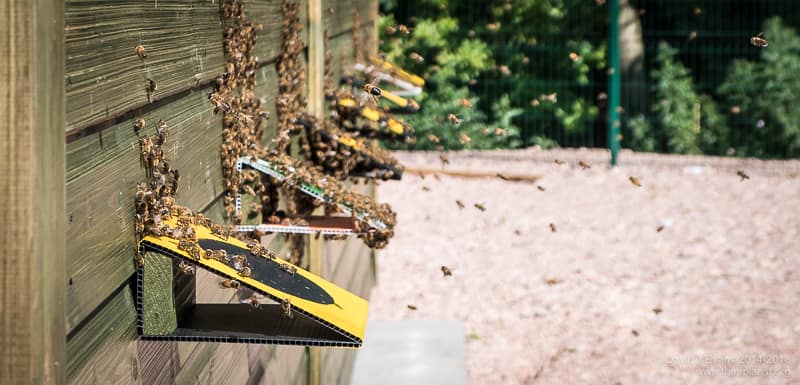
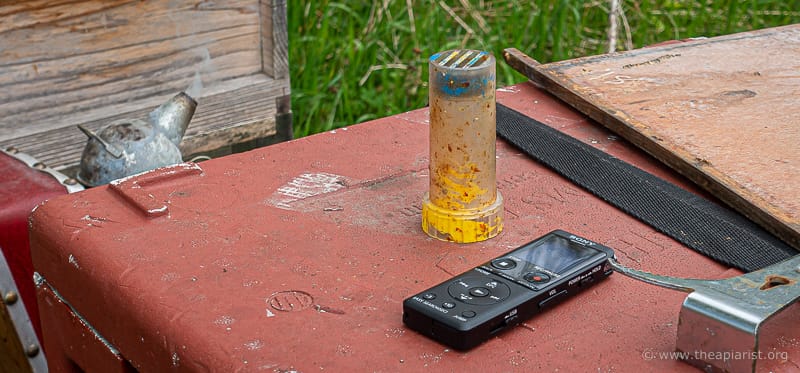

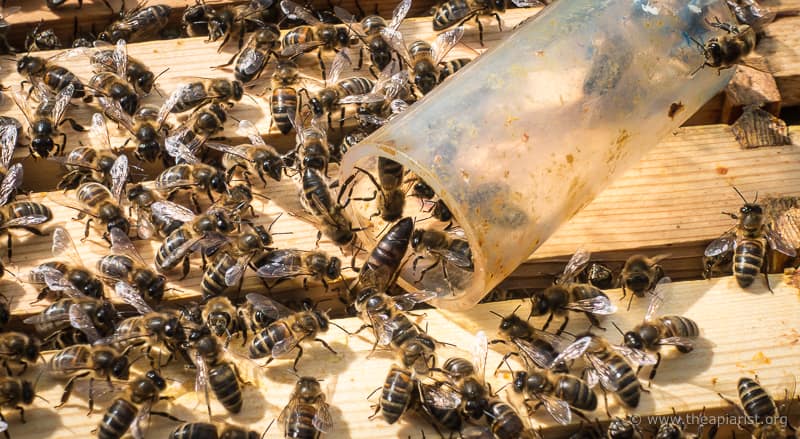
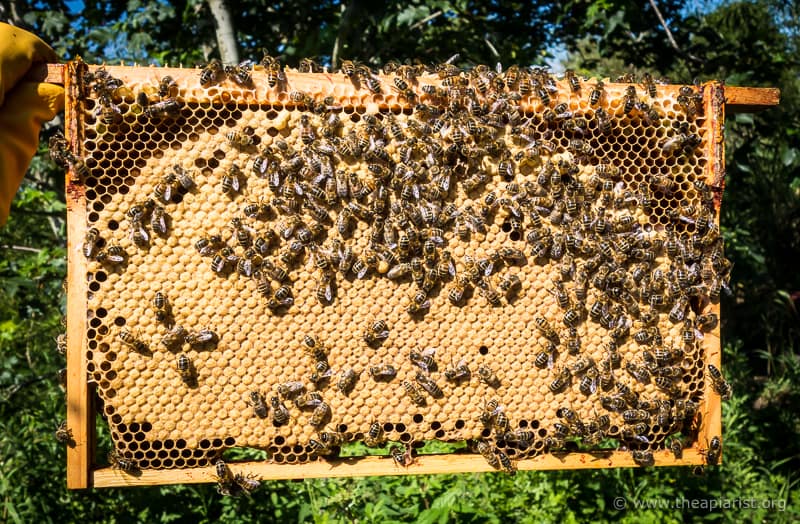
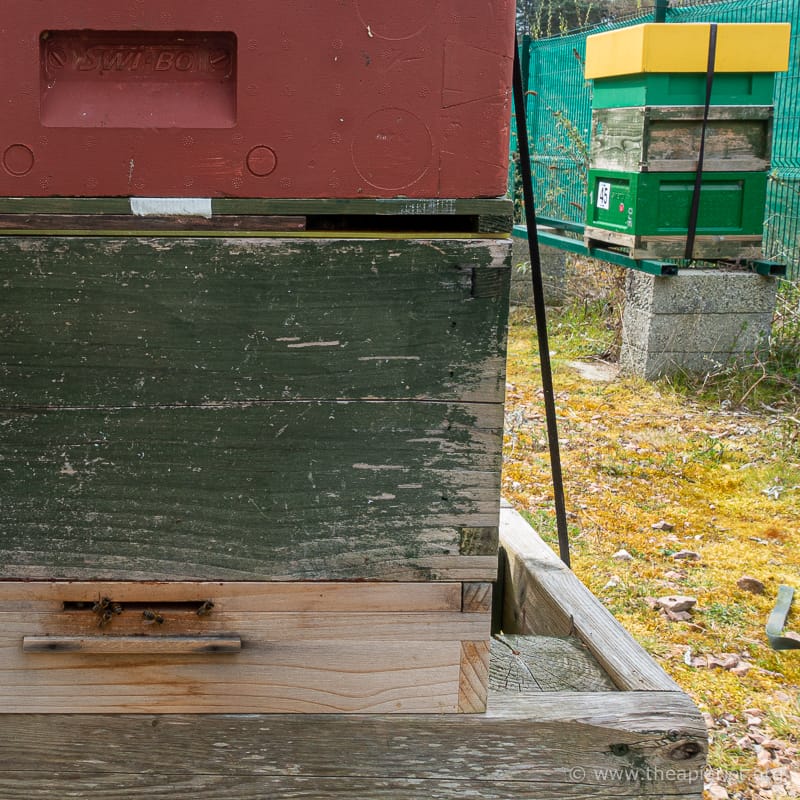

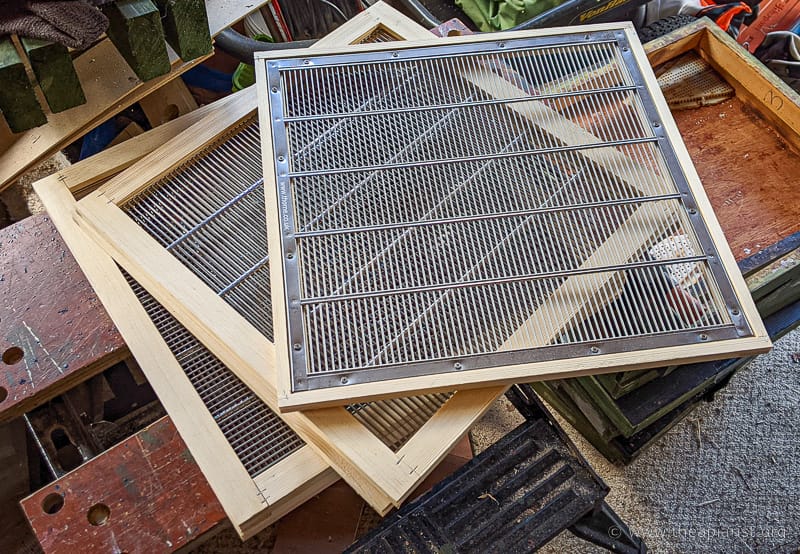
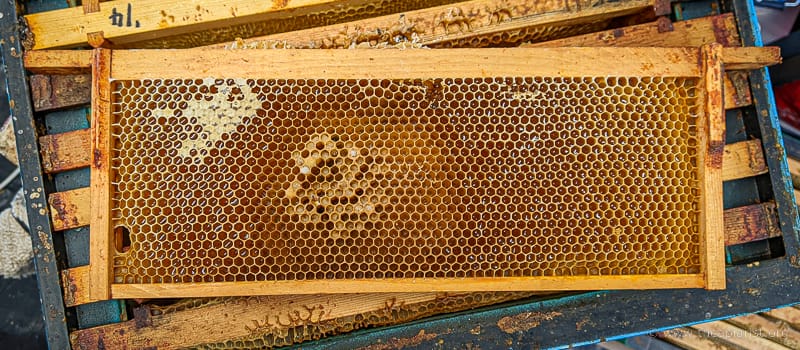
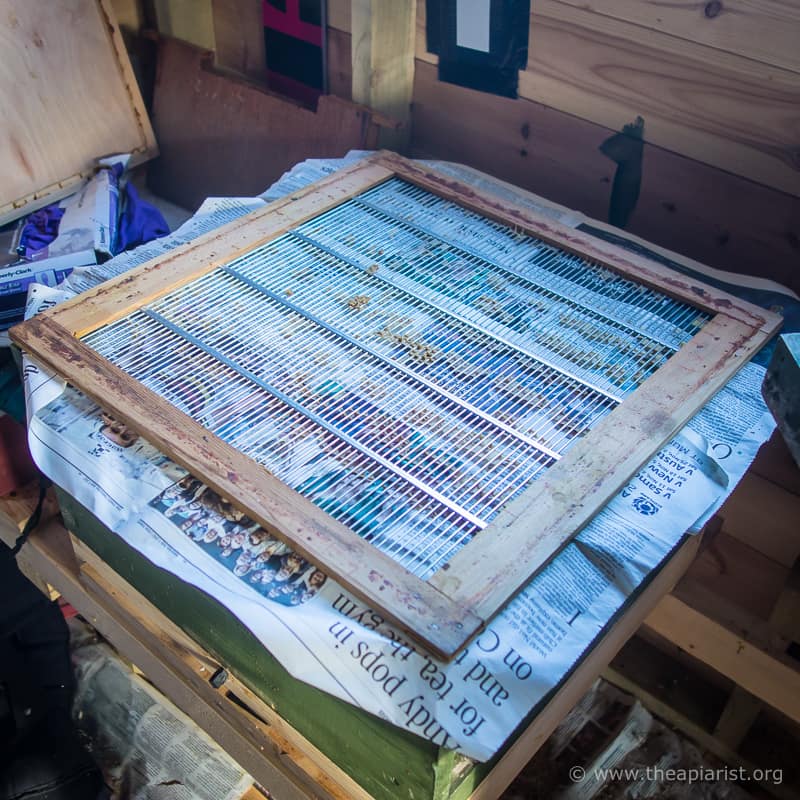
Join the discussion ...